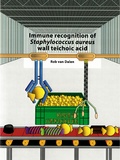Immune recognition of Staphylococcus aureus wall teichoic acid
Summary
The bacterium Staphylococcus aureus can often be found on our skin and in our nose, but also frequently causes severe infections. Especially infections with antibiotic-resistant S. aureus (MRSA) are difficult to treat. Rob van Dalen investigated the recognition of a unique structure of the S. aureus cell wall by the human immune system. New insights into these interactions may be used in the development of new treatment strategies against S. aureus.
Van Dalen specifically focused on a sugarcoated structure of the S. aureus cell wall, known as wall teichoic acid (WTA). He describes how S. aureus WTA is recognized by langerin, a receptor on skin immune cells and subsequently induces skin inflammation. Langerin discriminates S. aureus from other staphylococcal species. This may provide a possible explanation for the association between S. aureus, but not other staphylococcal species, and the allergic skin disease eczema.
In addition, Van Dalen developed a new method to analyze antibodies targeting WTA variants, which differ between group of S. aureus bacteria. Van Dalen produced the WTA variants in the lab, and used these to analyze their recognition by antibodies present in human blood. Using this method, he measured the recognition by antibodies on pure WTA, which greatly improved the sensitivity of the analytic assay. Beyond the use of these WTA compounds in analytical methods, they can potentially be used in an S. aureus vaccine.
Van Dalen’s work shows that WTA is a promising target for new treatment strategies against S. aureus.
